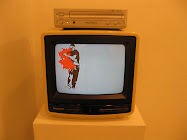The distinctive work of John Biggers emerges after the artist traveled to West Africa, digesting the geometric folk artwork of the culture he first experienced on an UNESCO trip in 1957. The Web of Life, completed in ’58, did not benefit from this new influence- befitting the plodding timeline of mural painting in America after the singular influence of Diego Rivera, the most visible of the Mexican muralists. Biggers’ iconography is taken literally from Rivera, with lanky worker figures (sparse versus Rivera, echoing the rural environment of African-Americans) as well as symbolic fetal figures and smooth, illusionistic rounded limbs at home with Leger’s cylindrical figures. A feminine biomorphism breathes mystery into the painting, as Lee Bontecou may have done twenty or thirty years later. This emerging characteristic of The Web of Life, after the wooden early attempts under the tutelage of regional muralists, is cut short by the cultural introspection of the artist’s identification with West African abstraction. Quilting Party (1981) is a dense and symbolic work, a reconciliation with Precisionism, Op Art, Hironymous Bosch, and Pattern and Decoration; as well as a refined taste for nocturnes and chiaroscuro. The symbolism of the triptych panels is as mythological as a ceiling fresco of the Carracci, albeit drawn from an altogether different history. Executed in conte crayon, the wax medium lends itself well to the dark tone of Biggers’ mood. The artist’s influence may well be measured in his dedication to Texas Southern University and the generation of painters currently working in Houston; Bert Long Jr., Rick Lowe, and Robert Pruitt.

















